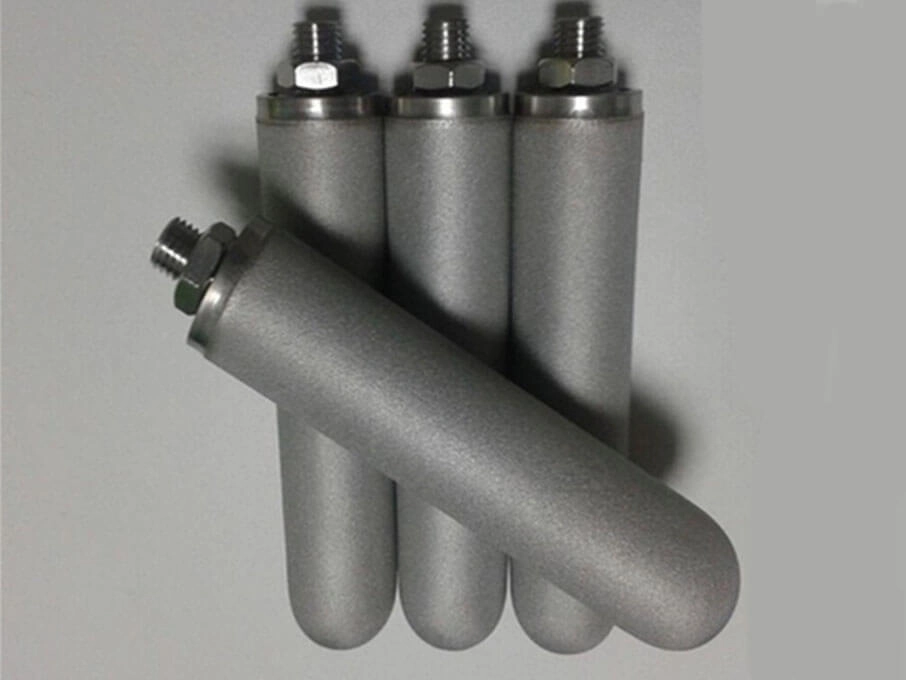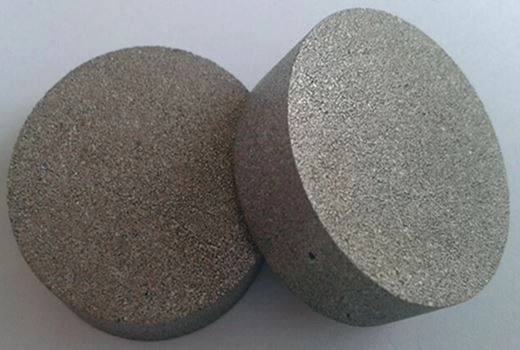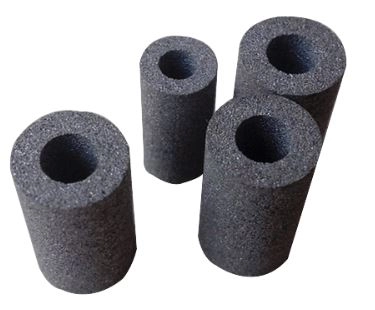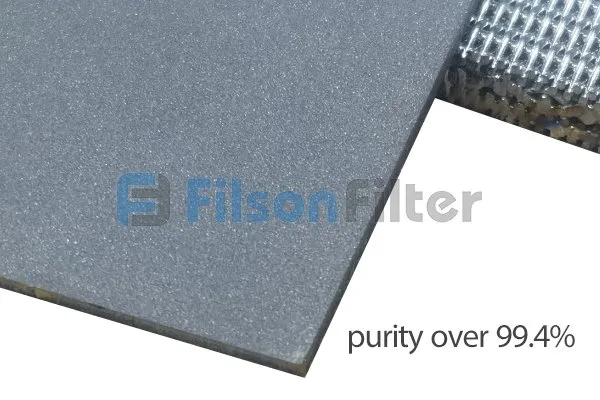Filson Sintered Titanium
- Uniform pore distribution with high porosity
- Easy to clean with long-lasting service life
- Various shapes and sizes for different applications
- Good chemical compatibility and resistance to acid and alkali
- Custom accuracy with high filtration efficiency
- Specifications
- Send Us Inquiry
Filson sintered titanium is an effective and ideal solution for a variety of water treatment, gas diffusion, chemical experiments, and pharmaceutical applications. With more than 18 years of experience in the filtration field, Filson is capable of assisting your sintered titanium projects.
- Material: pure titanium
- Purity: >99.4 %
- Operating Temperature: Max. 280℃
- Porosity: 28-50 %
- Micron Rating: 0.2-100 μm
- Diameter(filter): 20-120 mm
- Length(filter): 5”, 10”, 20”, 30”, 40”
- Differential Pressure: Max. 6 bar
Note: listed above for reference only, please consult Filson.
Send Your Inquiry Today
Filson Sintered Titanium
Your Preferred Sintered Titanium Manufacturer in China
Filson sintered titanium can be used to produce various porous and high-strength products, achieving superior temperature resistance up to 280℃ and high porosity of 28-50%. For the best system suitability, we provide adjustable micron ratings and flexible filter connectors.
Filson excels at manufacturing kinds of sintered titanium filters which are used pure titanium powder with a purity of over 99.4%. Besides, Filson standard sintered titanium filter has a 5-40 inch length, and we can also design filter sizes fully based on your actual installation needs.
Also excellent in temperature and corrosion resistance are sintered stainless steel filter, sintered nickel filter, sintered bronze filter or other metals filters. As a factory specializing in producing sintering filters, Filson is always able to provide you with satisfied filtration solutions.
Our technical support will be with you throughout your project. Click Here for a free quote.
Sintered Titanium: The Ultimate FAQs Guide
If you’re looking for high-grade sintered titanium, this has all the useful information you need.
Whether you want to learn about the chemical composition, benefits, applications, or quality testing – you will find everything here.
Keep reading to learn more.
What is Sintered Titanium?
A sintered titanium is a pure or alloy titanium that has been subjected to the process of powder classification, molding, and sintering.

Sintered titanium filter
What Grades of Titanium are there?
There are several commercial pure grades and alloys of titanium available for use in diverse industries and applications.
They include:
Grade 1
Titanium grade 1 is a pure commercial titanium grade with excellent formability, high impact toughness, and corrosion resistance.
This grade is the most ductile and softest of the titanium grades and is widely used in applications demanding high formability.
Grade 2
Commonly nicknamed the ‘workhorse’ of pure titanium, this grade is widely available and suitable for many applications.
It closely resembles grade 1 in properties but is much more robust.
Consequently, grade 2 has excellent cold-forming property and moderate strength.
Similarly, it has excellent weldability, ductility, and resistance to oxidation and corrosion.
Grade 3
This grade of commercially pure titanium has a higher strength than the first and second grades of commercially pure titanium.
It also has greater mechanicals than the early two grades.
It is slightly less formable but shares similar ductility levels as the predecessors.
You can use this grade in industries like aerospace and industrial processing that demand high resistance to corrosion and moderate strength.
Similar to other grades, grade 3 pure commercial titanium is available in numerous diverse forms.
Grade 4
It Is the strongest of the four commercial-grade pure titanium.
You can easily cold form it in addition to possessing excellent weldability and resistance to corrosion.
You can use grade 4 for a wide variety of applications though it is best suited for medical-grade titanium, where high-strength materials are fundamental.
Grade 7
Grade 7 is a titanium alloy formed after the addition of interstitial element palladium.
It has similar physical and mechanical properties as grade 2 but with enhanced corrosive resistance, especially reducing acids, making it the most resistant titanium alloy.
Besides, it also has excellent fabricability and weldability.
Because of its strong resistance to corrosion, this grade is suitable for processing chemicals and producing production equipment components.
Grade 11
It is an alloy formed following the addition of trace amounts of palladium to enhance its corrosive properties.
It closely resembles grade 1 titanium but with increased resistance to corrosion.
You can use this product in chloride environments where reducing acids and crevice erosion is a significant concern.
Ti 6Al-4V (Grade 5)
It is the most used titanium alloy accounting for half of the total worldwide titanium consumption.
It has numerous benefits, including:
- Increased strength through heat treatment
- You can use it at operating temperatures of up to 600F in welded constructions
- Lightweight
- Excellent resistance to corrosion
- Good formability and strength.
Ti 6Al-4V ELI (Grade 23)
Grade 23 is a highly pure version of grade 5 and shows superior tolerance to damages compared to other alloys.
You will select this grade if you need a combination of great anti-corrosion, high toughness, excellent strength, and lightweight.
It is widely used in the manufacture of dental and medical-grade equipment.
Grade 12
This grade of titanium alloy has a perfect rating for quality weldability.
It has the following key features:
- Very durable
- Excellent strength at high temperature
- Easy to form, cold or hot
- Excellent resistance to corrosion
- Close similarities to properties to stainless steel series 300
Ti 5AL-2.5Sn (Grade 6)
Possess great strength, creep and corrosion resistance, weldability, and stability at high temperatures.
Other alloy grades of titanium include:
- Titanium grade 7
- Titanium grade 9-Titanium 3AI-2.5V
- Titanium grade 19-Titanium Beta C
- Titanium 6AI-6V-2Sn-Titanium 6-6-2
- Titanium 6AI-2Sn-4Zr-2Mo-Titanium 6-2-4-2
- Titanium 6Al-2Sn-4Zr-6Mo-Titanium 6-2-4-6
- Titanium 8Al-1Mo-1V-Titanium 8-1-1
- Titanium10-2Fe-3Al
- Titanium 15V-3Cr-3Sn-3Al
- Titanium Alpha alloys
- Titanium Beta alloys
- Titanium Alpha-Beta alloys
What is the Composition of Titanium?
Titanium is a naturally occurring element on the earth’s crust and is also the seventh most abundant of naturally occurring metals.
You will readily find titanium as sediments derived from igneous rocks or as titanium oxides.
This metal also occurs naturally in the water bodies and living things.
Some of the most common minerals containing titanium include rutile, perovskite, brookite, titanite, and anatase.
However, only two of these minerals, ilmenite, and rutile, are of economic importance though you can rarely get them in sufficiently high concentration.
The naturally occurring titanium comprises five stable isotopes ranging from 46Ti to 50Ti, and isotope 48Ti is the most naturally abundant isotope.
What are the Properties of Sintered Titanium?
Sintered titanium possess the following key feature:

Sintered titanium disc
- Highly resistant to oxidation
- Excellent resistance to chemicals, especially to acids and alkali
- High porosity and minimal resistance to filtration
- Very high filtration efficiency
- Uniform and stable pore size and shape
- Can comfortably withstand up to 300C
- Does not allow particle fall off or secondary pollution
- Simple to operate
- Excellent mechanical strength
- Supports pressure and pumping filtrations
- Accommodates large flow
- Easy to clean
- Longer service life
- Non-toxic
- Non-magnetic
- Excellent formability into diverse shapes
What are the Benefits of Sintered Titanium?
You should consider using sintered titanium when your application is operating under the following conditions or in the presence of the following corrosive substance:
- Seawater
- Nitric acid
- Metal chromate chloride
- Wet chlorine, chlorite, and hypochlorite
- Organic salts
The sintered titanium will develop a thick and adhesive film of inert oxides over the material’s surface.
The film protects the sintered titanium against corrosion by passivation, enabling you to efficiently filter strong corrosive substances.
Sintered titanium is the most resistant metal against seawater corrosion.
It is also light in weight and has exceptional mechanical strength, making it suitable for high-speed and stationary seawater operations.
It has exceptional filtration abilities for other acid-base fluids.
What Methods of Sintering Titanium are there?
There are diverse methods of material sintering.
Some of the standard techniques include;
- Liquid phase sintering
- Direct metal laser sintering
- Electric current assisted sintering, including electro sinter forging and spark plasma sintering.
- Pressureless sintering
- Microwave sintering
What are the Advantages of Laser-sintering Titanium Alloys over the Traditional Methods?
Direct metal laser sintering is a 3D technology that utilizes software guidance to melt the powder metal at the sintering temperature.
It guides the laser as directed by the cross-sectional software model.
This process repeats itself several times while printing the powder metal layer by layer to completion.
This technology has the following benefits compared to traditional sintering methods:
- Dramatic reduction in waste materials
- Less costly and faster
- The process is fully automated hence operating at the least labor cost.
- No coolant costs and tool wears are associated with machining titanium.
- The technology can fabricate almost any product geometry.
How can you Produce Low-cost Titanium through Hydrogen Sintering?
You can produce near pore-free Blended elemental sintered titanium parts through sintering titanium hydride (TiH2) powder instead of the titanium powder.
A rise in temperature to moderate levels will dehydrogenate TiH2 before getting sintered at a higher temperature in the vacuum.
Alternatively, you can subject the TiH2 to sinter under controlled atmospheric partial pressure then transform the material by eutectoid.
You can then apply a moderate temperature to achieve dehydration.
This process is cheaper, produces near pore-free material with ultrafine grain sizes.
It also has superior tensile and fatigue features compared to traditional sintering methods.
How can you Produce Titanium Powder for Sintering?
You can produce titanium powder either through the following routes/methods.
· Sponge Production
Initially, you will extract titanium from the natural ore through chlorination then reduce the chlorides using magnesium or sodium.
Titanium sponge result as a result of the reduction process.
You can also distill the produced sponge in a vacuum for the removal of residual chlorine.
Melt and re-solidify for the formation of got.
You can also crush the sponge to form the powder.
However, you have to hydrogenate to crush it, given that titanium is very ductile.
Subject the product to vacuum heat treatment for dehydrogenation.
· Ingot Raw Material
The process is helpful where you need to create a product with higher purity levels.
Using a feedstock with lower oxygen levels, nitrogen and chlorine, apply hydrogenation to form brittle TiH2.
Crush it into a powder then reheat in a vacuum for dehydrogenation and formation of powdered titanium powder.
· Plasma Rotating Electrode Process (PREP)
You can use this method for the preparation of spherical powders.
You can use it to prepare commercially pure or alloyed titanium powder.
The feed material, a consumable electrode, is a metal bar that is either pure or alloyed.
Working in an inert atmosphere, spun the bar at a very high speed while melting its end by gas plasma arc.
The process produces small metal droplets that fly away from the melting end and form spherical titanium powder.
· Gas Atomization
This process utilizes wire as the feedstock for the production of spherical titanium powder.
Using this process, you can either produce pure or alloyed titanium or even a titanium aluminide composition.
This process has a faster cooling rate compared to PREP.
It also produces finer powdered particles compared to PREP.
Other titanium production processes include:
- Chen-Fray farthing
- Rotating electrode process
What Applications use Sintered Porous Titanium Powder?
Sintered titanium is exceptionally resistant to corrosion and highly suitable for constructing filters for use under alkaline and acidic environments.
You can use either bright titanium.
Black titanium constitutes pure titanium wire coated using graphite and is highly suitable for filtration in seawater or ship applications.
On the other hand, bright titanium lacks the graphite coating but has a pure woven titanium wire underneath.
You can use this type of titanium to construct fine chemical filters, electrode nets, battery collecting nets, etc.
Generally, you can use sintered titanium in diverse industries demanding strong resistance to chemicals with excellent formability.
Specifically, the sintered titanium filter in the following industries:
- Pharmaceutical
- Food and beverage
- Petrochemical
- Chemical
- Water treatment
- Biological engineering
- Gas purification
- Metallurgy
- Military
You can use it for:
- Preliminary filtration of seawater during desalination
- Filtration of chemical liquids
- Manufacture of electromagnetic shield net
- Construction of high-temperature filters
- Manufacture of ships, mechanical filter
- High-temperature electric furnace heat treatment tray
- Petroleum filters

Sintered titanium
What Powder Factors Affect the Performance of the Sintered Titanium Powder?
There are several characteristics of titanium powder, which can significantly influence sintered powder products’ characteristics and performance.
Such factors include:
· Powder Morphology
Shape and size of powder as a result of the production process.
Different powder production methods can deliver either spherical, sponge, or angular-shaped titanium powder.
· Powder Chemistry
The powder chemistry can be defined in terms of content impurities.
Impurities such as magnesium and hydrogen can arise from the powder production process while others originate from the source.
Other common contaminants include nitrogen, oxygen, carbon, sodium, chlorides, etc.
· Powder Mesh Distribution
This factor significantly influences how the powder will be compacted.
· The Apparent Density
Achieving the highest possible green density is highly desirable for the compaction process.
Apparent density determines the quantity of powder you need to add and achieve the desired final green density.
· Powder Hall Flow Rate
It is the time required to empty a unit quantity of powder through a nozzle of a given fixed diameter.
It is a key factor that influences the die filling process.
· Powder Compressibility
Powder compressibility depends on the particle hardness and powder morphology.
You will use it to determine the amount of pressure required to compress a green density unit.
· Powder Green Strength
It is the transverse rupture strength of a green compact at a given compaction pressure.
It helps determine whether you need to conduct any further handling and processing before sintering.
What Factors Affect the Machinability of Sintered Titanium?

Sintered titanium
Several factors influence the overall machinability of the sintered titanium product.
Usually, you can test the machinability of a sintered titanium through face-turning machining.
Generally, sintered titanium is characterized by poor machinability because cutting it is very difficult.
Good machinability is associated with ease of cutting, low cutting tool wear, long tool life, low cutting forces, and easy removal of continuous chip forms.
The following factors will significantly influence the ease or difficulty of machining sintered titanium.
- The method of powder production used
- The type and mixture of powders in alloyed products
- Contents of powder mixtures such as the lubricants and alloying elements
- The compaction pressure, lubrication method, and how you carry out the lubrication
- Material porosity
- Sintering temperature and atmosphere,
- The gas flow rate, sintering time, and rate of cooling.
- Variations in product microhardness
- The wear rate of the cutting tool
How can you Improve the Machinability of Sintered Titanium?
You can improve sintered titanium machinability by selecting the right combination of high-speed machining tools, conducive cutting environments, and high-quality cutting tools.
A well thought of combination will lower the cost of machining and improve the surface finishing and integrity.
What is an Isostatic Pressing of Sintered Titanium Powder?
Isostatic pressing is a technology applied for press and sinter methods of manufacturing sintered titanium.
You can use either cold isostatic pressing (CIP) or hot isostatic pressing (HIP).
These two processes reduce the powder mixture’s porosity into desired material shapes and sizes.
The CIP is suitable for an economical fabrication of low volume, highly uniform, and complex-shaped products.
You can produce long and slender parts faster using the CIP technique.
In the case of HIP, you have to apply pressure and heat while pressing simultaneously.
You should select the HIP method when working with parts requiring exceptional properties or powder that isn’t easy to sinter.
Currently, the majority of sintered titanium is fabricated using the HIP to obtain the desired product characteristics.
What Kinetics are involved in Sintering Powdered Titanium?
Sintering powder titanium happens between 1200 to 1400°C, about 72 to 84 % of titanium’s melting point temperature, 1668°C.
You should conduct the sintering in a vacuum since titanium is very reactive to a gaseous substance at a temperature beyond 400°C.
The reaction, especially with oxygen, has negative impacts on the final product properties.
The final sintered product properties significantly rely on the sintering time, atmosphere, temperature, type and size of powder, and compaction pressure.
Smaller mean powder size results in final products with higher sintered density.
Similarly, an irregularly shaped particle will deliver a higher green density than a spherical powder of a similar mean size.
Sintering temperature confers a more significant influence on the dimensional stability and changes of the sintered titanium than sintering temperature and time.
What Filtration Products can you Construct using Sintered Titanium?
You can fabricate numerous filtration devices using sintered titanium.
Some of these products include:

Sintered titanium plate
- Sintered titanium powder filter cartridge
- Sintered titanium filter plates
- Porous titanium filter cartridge
- Micro pure sintered titanium powder sintered metal filter discs.
- Sintered titanium microporous filter plates etc.
How can you Test the Mechanical Characteristics of Sintered Titanium?
Your sintered titanium products’ mechanical properties significantly depend on the impurity concentration, grain size, and sintered density.
You can perform most of these tests as described by the various quality standards relating to the test. They include:
· Microhardness
You can use either the Knoop or Vicker test according to the specifications of ISO 3878 and ISO 4507 for hard metals and sintered ferrous metals, respectively.
The test measures the product’s true hardness by determining the hardness of constituent phases.
· Sintered Density
You can follow the guidelines of ISO 2738 for the determination of open porosity and the density of the sintered titanium.
· Tensile Test
Conduct the test as per specifications of ISO 2740 on a standard pressed sintered titanium bar.
· Bend Test
You can use ISO 3995 guidelines to test for this feature.
You should carry out this test to determine the bending strength of sintered titanium on pressed sintered titanium.
· Fatigue Test
You can use a combination of different stresses or either torsion, ending, or axial loading stress.
Follow the guidelines specified under ISO 3928 for this test.
· Microstructure Test
You can conduct a metallographic analysis using optical microscopes and appropriate image software.
- Un-notched impact test
You should conduct following the requirements of ISO 5754.
It determines the product’s ability to resist shock by subjecting the test piece to shock weights produced by falling loads.
Toughness is indicated by the energy absorbed by the test piece.
What are the Advantages of Using a Sintered Titanium Filter?
Titanium sintered porous metal filters are suitably designed for applications associated with gases, heat, polymers, cryogenics, and aggressive chemicals.
These filters have the following advantages:
- Have fixed pore structures and rugged surfaces suitable for extreme temperatures and pressure
- Lacks longitudinal seams
- Available in over a wide range of micron ratings and configurations suited for top performance over a wide diversity of applications
- Provides excellent resistance to corrosion from seawater and numerous chemicals
- Supports easy cleaning, which allows re-usability and minimizes operational costs
- No migration of media is ensured through high-temperature sintering.
- Excellent mechanical strength capable of maintaining stability under high pressure
- Can last up to 30 years with proper care and maintenance
- Supports high flow rate at a low-pressure drop
- Higher dirt holding capacity
- Can be operated over a wide range of temperatures
What are the Drawbacks of using Sintered Titanium Filters?
Generally, sintered titanium provides superior filtration features, especially under extraordinarily demanding and corrosive environments, to other materials.
However, superior qualities come with financial implications.
As expected, sintered titanium filters usually cost much more than other common materials like sintered steel.
The material itself is hard and has low heat conductivity, making handling and machining very difficult and costly.
How can you Determine the Porosity of Sintered Titanium?
You can determine the porosity of material using different methods.
You can follow Archimedes’ technique, which also determines the apparent and bulk densities.
Alternatively, you can cut the specimen transversally and prepare it using the standard metallographic method.
You can then perform the analysis using a scanning electron microscope.
The optical microscope enables you to perform quantitative metallographic analysis by taking several random images then subjecting to an image analysis software.
The software will help you determine the pore size range and percentual porosity.
What Factors Affect the Filtration Efficiency of a Sintered Titanium Filter Cartridge?
The filtration efficiency of a sintered titanium filter cartridge depends on:
- Dirt holding capacity of the filter
- The porosity of the filtration media
- The micron rating for the cartridge
- Dirt load of the incoming fluid
- The fluid flow rate
- The system pressure and operating temperatures
- Chemical compatibility with system fluid
- Type and nature of contaminants etc.
In short, there are many factors you should consider when choosing sintered titanium.
Remember, metal sintering is a versatile technique you can use for a range of applications such as sintered nickel, sintered stainless steel sheet, and sintered bronze filters, amongst others.
We hope this guide makes everything simple for you.
For inquiries or free consultations, talk to FilSon Filters team now.
